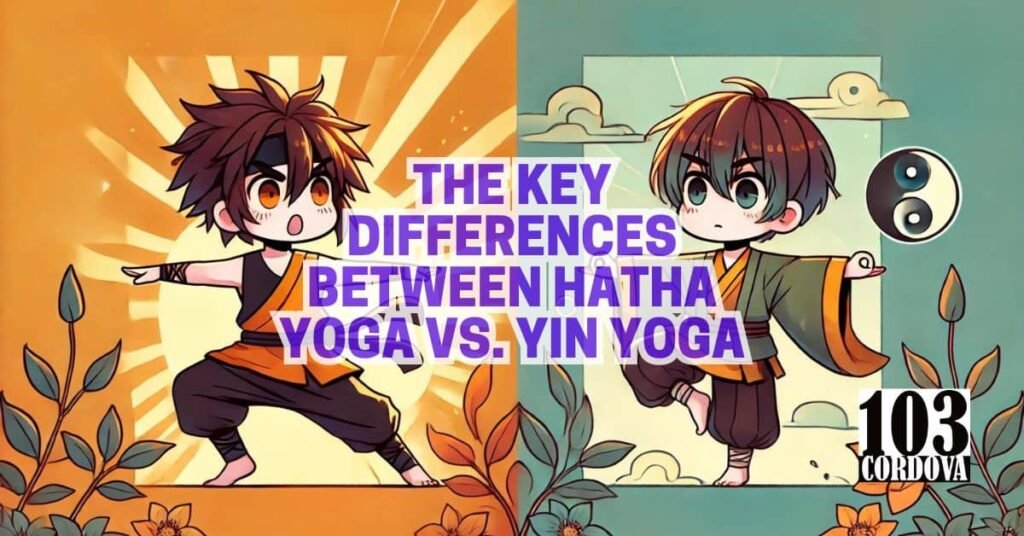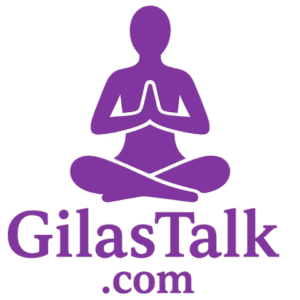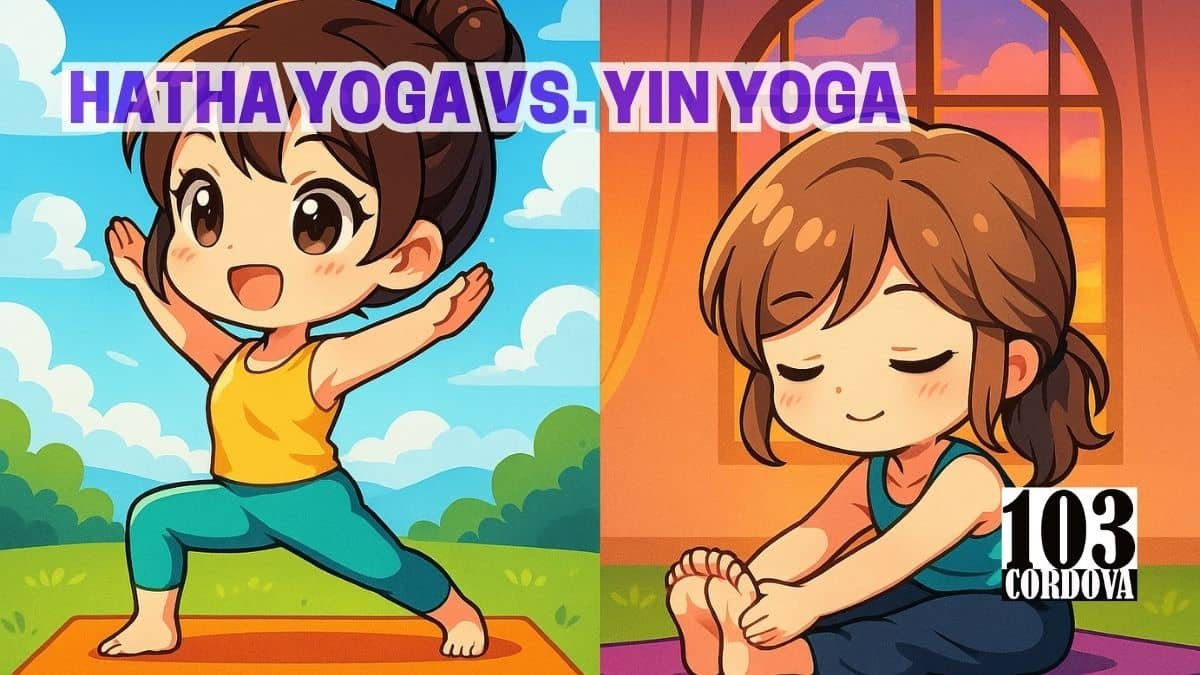Hatha Yoga and Yin Yoga are two popular styles that help people move their bodies and calm their minds in different ways.
Hatha Yoga uses active movements and poses to build strength, balance, and flexibility.
Yin Yoga is much slower and focuses on holding gentle stretches for a long time to relax the deeper parts of the body.
When comparing hatha yoga vs. yin yoga, it’s important to know what each style offers so you can choose what works best for you.
We’ll explain the main differences to help you decide which style fits your needs and lifestyle.
1. Hatha Yoga vs. Yin Yoga: Origins and Principles
Hatha Yoga originates from ancient India, where it evolved as a system aimed at balancing both the body and mind through physical postures and breath control.
Traditionally, it is seen as a preparatory practice for deeper meditation, aligning breath with movement to create harmony within.
Hatha Yoga serves as the foundation for many other forms of yoga, such as vinyasa yoga, which builds on its principles but incorporates a more dynamic flow of movements.
Yin Yoga, on the other hand, has its roots in modern practice and is influenced by Taoist principles, emphasizing the flow of energy through stillness and deep, passive stretches.
Unlike the active engagement in Hatha Yoga, Yin Yoga encourages practitioners to remain in poses for several minutes, targeting the body’s connective tissues.
Both styles offer unique benefits, with Hatha fostering strength and balance, while Yin provides opportunities for deep relaxation and improved joint flexibility.
Yoga teachers often integrate these distinct practices to provide a well-rounded experience, sometimes incorporating other styles like kundalini yoga to further enhance spiritual and energetic development.
🧘 The Importance of Yoga Room Size for Both Group and Individual Practice
2. Class Structure: What to Expect in Hatha Yoga vs. Yin Yoga
A typical Hatha Yoga class features a structured sequence of standing, seated, and balancing postures, each transitioning smoothly into the next.
The practice is generally moderate in pace, allowing students to focus on aligning their breath with movement, often incorporating pranayama techniques to control and deepen the breath.
Hatha Yoga shares similarities with other styles like Ashtanga, which also focuses on dynamic sequences but tends to follow a more rigid structure.
In contrast, Yin Yoga takes a much slower approach, with fewer poses held for extended periods, often up to five minutes or more, allowing for deep, passive stretching.
Unlike the flow found in Hatha or Vinyasa classes, Yin encourages stillness and a meditative state within each pose, promoting relaxation of the body’s deeper connective tissues.
Yin Yoga shares qualities with restorative yoga, but while restorative yoga focuses on healing and comfort, Yin aims to stretch and release tension in joints and fascia.
The contrasting structure of Hatha and Yin Yoga reflects the varied physical demands of each style, offering different approaches to body-mind connection.
🧘 Designing a Yoga Room Schedule to Boost Class Attendance
3. Intensity and Pace: Hatha Yoga’s Dynamic Approach vs. Yin Yoga’s Relaxed Practice
Hatha Yoga often involves dynamic movements and short holds, which can make it a more intense style of yoga aimed at building both strength and endurance.
This style incorporates a moderate pace with a focus on alignment and breath control, ensuring that practitioners remain engaged while still working on their flexibility and balance.
Unlike faster types of yoga, such as power yoga, which push the body to its limits through continuous and vigorous movements, Hatha maintains a steadier rhythm.
Yin Yoga, on the other hand, takes a completely different approach with its slow and relaxed pace, focusing on long-held postures that allow the body to deeply stretch and release tension.
Although Yin Yoga may seem less intense, it presents its own challenges, both physically and mentally, as practitioners hold poses for several minutes at a time.
The intensity in Yin comes from the deep engagement with the body’s connective tissues, rather than building muscle or endurance as in Hatha or power yoga.
Each style of yoga caters to different goals and fitness levels, offering unique ways to engage with the body and mind, depending on the intensity and pace you prefer.
🧘 Safe Techniques and Tips for Mastering the Advanced Wheel Pose
4. Physical Benefits of Hatha Yoga and Yin Yoga
Hatha Yoga offers significant physical benefits by working through a variety of asanas, or poses, that strengthen different muscle groups and improve overall balance and flexibility.
As yogis engage in regular Hatha practice, they develop better posture, enhanced core stability, and greater endurance, which can positively impact daily activities and other types of exercise.
Yin Yoga, on the other hand, works deeper into the body’s connective tissues, such as ligaments and fascia, helping to improve joint health and increase long-term flexibility.
By holding poses for extended periods, Yin Yoga also helps release chronic tension and promotes relaxation, easing stiffness in areas that might otherwise go unnoticed in more active styles of yoga.
The contrast between Hatha’s dynamic strength-building asanas and Yin’s focus on passive stretches creates a balance akin to yin and yang, making both styles ideal for a well-rounded yoga practice.
Practicing both Hatha and Yin Yoga allows a yogi to enjoy the benefits of increased physical strength while also supporting the body’s flexibility and relaxation.
Together, these styles foster physical well-being in complementary ways, enhancing overall body function and health.
🧘 How a Dedicated Breathing Space Can Elevate Your Yoga and Wellness Practice

5. Breath Control: Active Breathing in Hatha Yoga vs. Passive Breathing in Yin Yoga
In Hatha Yoga, breath control is a central aspect of the practice, with active breathing techniques used to synchronize movement and breath.
This deliberate breathwork helps regulate energy flow and maintain focus throughout the session.
Yin Yoga, however, emphasizes a more passive form of breathing, where practitioners are encouraged to let the breath flow naturally without effort.
The goal is to relax into the poses rather than control the breath.
This difference in breathing style reflects the overall energy of each practice, with Hatha being more active and Yin more calming.
🧘 Selecting the Ideal Ashtanga Yoga Mat for Your Sessions
6. Pose Duration: Short Holds in Hatha Yoga vs. Long Stretches in Yin Yoga
In Hatha Yoga, poses are generally held for shorter durations, usually between 30 seconds and one minute, before transitioning to the next posture.
This allows for a continuous flow of movement that challenges both strength and flexibility.
Yin Yoga, on the other hand, requires holding poses for longer periods, sometimes up to five minutes or more, to target deeper layers of connective tissue.
The extended hold times help release tension and improve joint flexibility.
These differences in pose duration align with the distinct goals of each practice, with Hatha focusing on active engagement and Yin emphasizing deep relaxation.
🧘 What Sets Bikram Yoga Apart: Unique Poses and Health Benefits
7. Target Areas: Muscles in Hatha Yoga vs. Connective Tissues in Yin Yoga
Hatha Yoga primarily targets the body’s muscles, helping to build strength, increase flexibility, and improve endurance.
Each posture actively engages various muscle groups, creating a full-body workout that enhances overall fitness.
Yin Yoga, in contrast, works on the connective tissues such as ligaments, tendons, and fascia by gently stressing these areas through long-held poses.
This practice helps improve joint mobility and maintain healthy connective tissue, which can become stiff over time.
Both styles serve different but equally important purposes for maintaining physical health.
🧘 Enhancing Mind-Body Connection with Somatic Yoga Therapy
8. Mental and Emotional Impact: Energizing Hatha Yoga vs. Relaxing Yin Yoga
Hatha Yoga uses movement and breath to wake up the body and clear the mind, which can help people feel more focused and alert during the day.
Its steady flow of poses can lift your mood, boost energy, and sharpen thinking, especially when practiced regularly.
Yin Yoga is slower and more still, using long holds to encourage the body and mind to settle down.
This quiet style helps reduce stress by slowing the heart rate, relaxing the muscles, and creating space for self-awareness.
Influenced by ideas from Chinese medicine, Yin Yoga also works with the body’s energy lines to support emotional balance.
While Hatha Yoga helps you feel awake and ready, Yin Yoga helps you let go of tension and rest more deeply.
Both styles offer different paths to improving how you feel inside and out, depending on what your mind and body need.
🧘 How Chair Yoga Teacher Training Can Improve Your Skills and Student Interaction
9. Best Times of Day to Practice Hatha Yoga and Yin Yoga
Hatha Yoga is often practiced in the morning because it helps wake up the body and gives energy for the day ahead.
Its active poses and movements can make you feel alert and ready to start your morning.
Yin Yoga is more gentle and calming, making it a good choice for the evening when you want to relax and let go of stress.
Practicing Yin Yoga at night can help you unwind and prepare for better sleep.
Choosing the right time of day for each style can help you get the most out of your yoga practice.
🧘 Does Yoga Help Tone Your Body? Tips to Maximize Physical Benefits
10. Props and Equipment: Support in Hatha Yoga vs. Deepening Stretches in Yin Yoga
In Hatha Yoga, props such as blocks, straps, and bolsters are often used to support alignment, assist in balance, or modify poses for varying levels of flexibility.
These tools help practitioners achieve correct postures and safely push their limits in more challenging positions.
Yin Yoga also makes extensive use of props, but the focus is on deepening stretches and maintaining comfort in long-held poses.
Bolsters, blankets, and pillows are used to support the body, allowing muscles to relax fully and encouraging the release of tension.
While both styles use props, their purposes differ to match the goals of each practice.
🧘 Dive into the World of Yoga Secrets
11. Choosing the Right Yoga Style: Hatha Yoga vs. Yin Yoga for Your Goals
Selecting between Hatha Yoga and Yin Yoga depends largely on your personal goals and what you hope to achieve from your yoga practice.
If your goal is to build strength, improve flexibility, and engage in an active practice, Hatha Yoga may be a better choice.
On the other hand, if you seek relaxation, stress relief, and improved joint mobility, Yin Yoga might suit your needs more effectively.
Understanding your physical and mental objectives can guide you in choosing the practice that aligns best with your lifestyle.
Many people find that combining both styles offers a balanced approach to their overall well-being.
💡 Conclusion
Hatha Yoga and Yin Yoga are two distinct yet complementary practices that offer unique benefits for the body and mind.
While Hatha Yoga provides a more dynamic, strength-building approach, Yin Yoga focuses on deep relaxation and flexibility through longer, passive poses.
Both styles can serve different purposes depending on your goals and needs, whether you’re looking for physical engagement or mental calm.
By understanding the key differences between these two practices, you can choose the style that resonates most with your personal preferences and well-being.
Embracing both practices can create a well-rounded yoga routine that addresses various aspects of health.
🧘 Our Services
Experience the benefits of yoga with our classes tailored for all ages at 103 Cordova Tower, Marquinton Residences, Cirma Street, Sto. Nino, Marikina City.
Whether you’re a beginner or an experienced practitioner, our sessions are designed to enhance your well-being through mindful practice.
Connect with us today by calling 09176225780, messaging us on Facebook, or filling out our contact form.
Our welcoming environment ensures everyone can enjoy the many benefits of yoga.
Join us and start your journey to a healthier and more balanced life.

